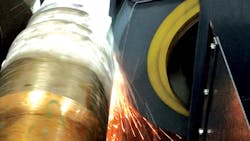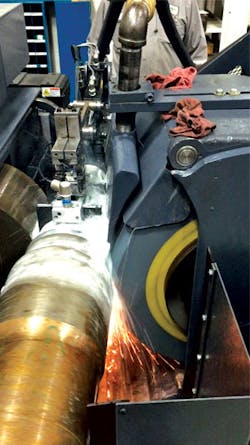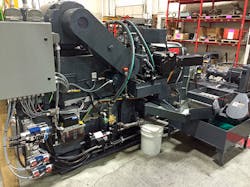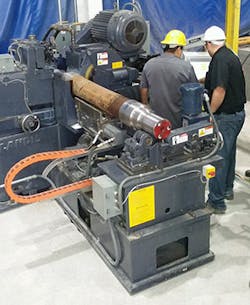Machining heavy forged parts requires precision, skill, and experience, but first of all, it requires reliable power and process control. APeC Integration Services Inc. is an electrical systems integrator that specializes in machine tool updates, and one of its recent projects was to plan and carry out a comprehensive overhaul and upgrade of high-power centerless grinding machines for a railcar axle manufacturer.
Simplifying precision grinding for the heavy-duty forgings started with a CNC control platform retrofit.
Modernizing PLCs and CNC controls is a specialty for Wattsburg PA-based APeC, which was established in 1989, and works with manufacturers to maximize the longevity and performance of their production machinery. Its retrofit services include upgrading servo and spindle motors and drives, PLC integration and custom machine controls, and complete CNC replacement.
The machine tools in the axle-grinding project are high-capacity Landis centerless grinders that use a dressable grinding wheel and a plunge grinding cycle to create precision profiles on the axle journals.
During grinding, both the axle workpiece and the grinding wheel rotate in the same direction, which means that the two surfaces are moving in opposite directions at the point of contact, resulting in smoother operation. Once the machine is up to speed, the grinding wheel is fed, or ‘plunged’, into the workpiece and makes continuous contact with a single point along its length.
The plunging action is controlled by a servo-driven axis grinding at several feed rates, with transition points monitored by in-process gauging. A built-in, automated two-axis dresser system with a diamond-tipped tool is used to dress the grinding wheel whenever necessary.
This was the second time that APeC has improved the performance of these grinders, both times working with control systems based on the Flexium platform developed by NUM AG.
The original machines were hydraulically actuated and equipped with tracer-type wheel dressing systems. In the mid-1990s, APeC performed a full mechanical and electrical upgrade on each machine that included retrofitting a modern CNC system and in-process gauging instruments. At that time, the update was based on NUM’s Power 1060, which was seen as one of the most flexible and user-friendly CNC systems available.
After 20 years of full-time service in a busy production environment, the machines were due for another mechanical and electrical upgrade. APeC had supported the machines and worked closely with their operators throughout, and during that time it had developed a number of ideas to make the machines even easier to operate and more productive. The new update program offered an opportunity to apply those.
To expedite machine upgrades and minimize the impact on the forger’s production schedules, APeC managed a three-way development partnership. Euro Machinery Specialists Inc., a machine tool rebuilder, handled all major mechanical re-design, hydraulic, lubrication, and geometrical rebuilding aspects of the project.
On the control side, APeC collaborated with NUM USA to develop an intuitive human-machine interface. This enabled the operators to learn how to use the machines very easily and quickly—even if they are unfamiliar with these types of grinders.
Customer benefits included improved worker satisfaction, less need for training, and increased machine productivity.
“One important project goal was to simplify machine operation as much as possible,” according to APeC’s Dave DeCoursey. “NUM’s open Flexium CNC platform provided the control flexibility and HMI customization facilities that we needed to develop individual, task-oriented screens. The user interface is consequently now much more ergonomic.”
He continued: “Most operations, such as offset calculations, calibration, dressing, and automatic grinding cycle initiation, are now performed using single, virtual pushbuttons that are only displayed when appropriate.”
Each machine upgrade used several NUM products, including the CNC kernel, touch-sensitive operator panel, servo drives, and motors. The Flexium CNC system uses EtherCat I/O communications, making it simple for APeC to implement an advanced plunge depth control architecture.
The in-process gauging instrumentation previously used for this aspect of machine operation was replaced by a linear encoder for fast and accurate depth control as well as to provide real-time feedback to the operator throughout the grinding cycle.
The main control screen features two large, analog-style dials, supported by digital displays, which derive their input data from separate measurement probes located along the length of the axle journal, allowing the operator to monitor taper tolerance very easily.
The client and application-specific HMI software that APeC developed for the grinding machine upgrade is task-oriented: It uses individual screens that are tailored to the application, with clear, context-sensitive functions that help to prevent human error. By using the Extended NCK Access (ENA) facilities of the Flexium CNC controller, each custom PLC-driven visualization can control and monitor the CNC functions directly. This form of control approach is especially useful for automated, teach-type functionality, such as guiding an operator through machine start-up and preparing for automatic cycles.
For example, the start-up screen initially displays only the status of the CNC system and a single ‘shutdown’ button. As soon as the CNC system indicates that it is ready, the start-up screen displays two additional buttons: Home Screen and Manual Operation. When the operator touches a displayed button and causes a change of screen, the software automatically alters the CNC mode accordingly and selects the corresponding part program if applicable.
By confining the operator’s available options to just those that are appropriate at the time, the software helps to ensure consistent and efficient machine use.
Another significant advantage of this type of control approach, with extended access to the NCK, is that it can be used to help the operator with tool offsets and adjustments to part program dimensions. When the grinding wheel or dressing tool is replaced, the operator can manually position the tool on the desired surface of the wheel, access a password-protected screen and then simply press a button. The offsets are calculated and pushed into the dressing program automatically, using the ENA facility. This same functionality allows the operator to alter dressing dimensions and sparkout setpoints simply by adjusting a value up or down—these are then pushed into the corresponding part program.
“The open architecture and advanced functionality of Flexium CNC systems enable engineering companies to implement innovative machine control solutions for retrofit or new machine tool projects,” summarized Steven Schilling, general manager of NUM Corp., Naperville, IL.
“In this instance, APeC and Euro Machinery Specialists, with NUM’s support, have created a CNC retrofit that adds significant value to the customer’s existing manufacturing facilities.”
About the Author
Robert Brooks
Editor/Content Director - Endeavor Business Media
Robert Brooks has been a business-to-business reporter, writer, editor, and columnist for more than 20 years, specializing in the primary metal and basic manufacturing industries. His work has covered a wide range of topics including process technology, resource development, material selection, product design, workforce development, and industrial market strategies, among others.
Currently, he specializes in subjects related to metal component and product design, development, and manufacturing—including castings, forgings, machined parts, and fabrications.
Brooks is a graduate of Kenyon College (B.A. English, Political Science) and Emory University (M.A. English.)





